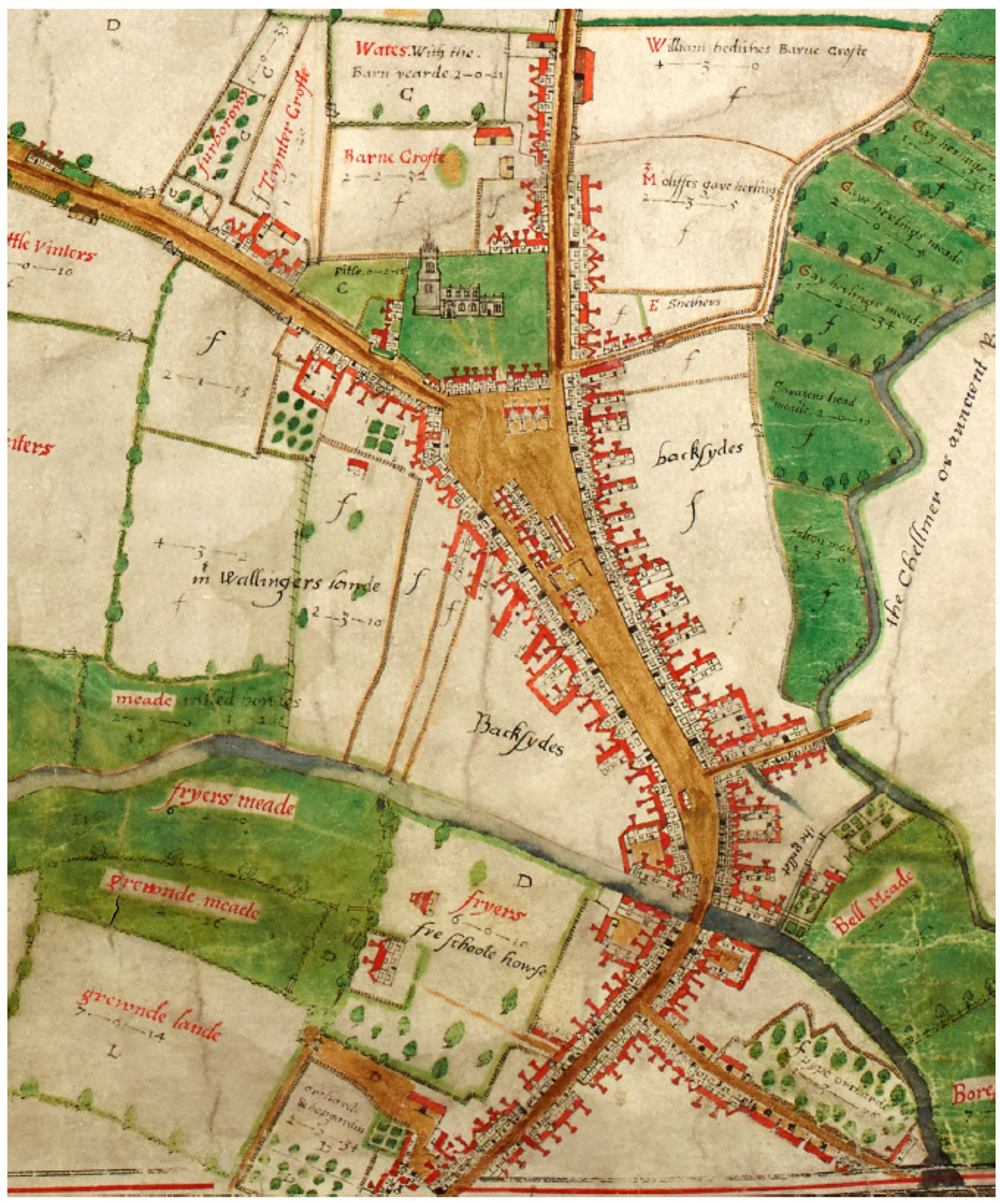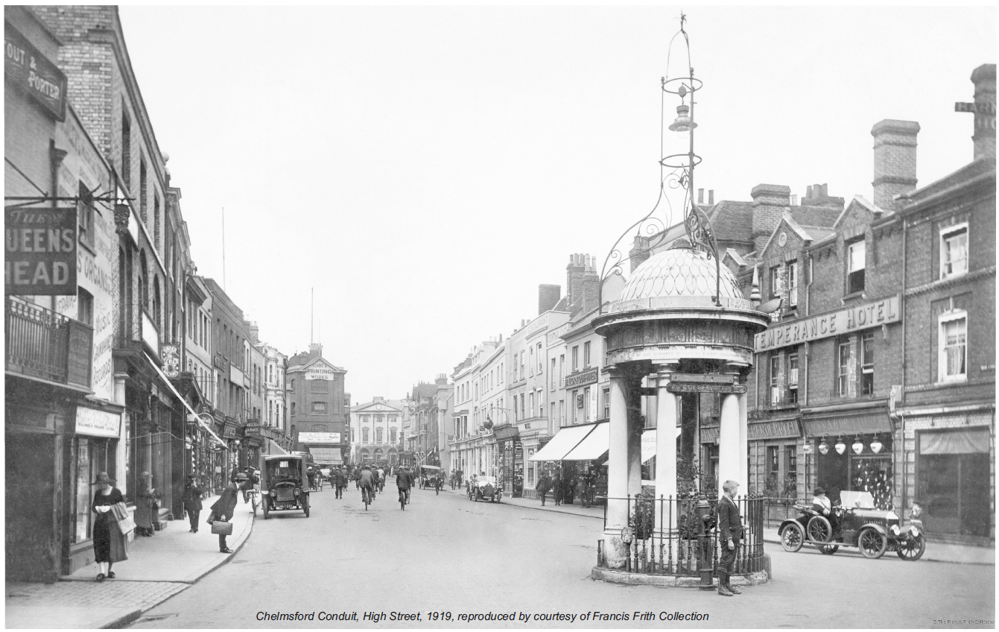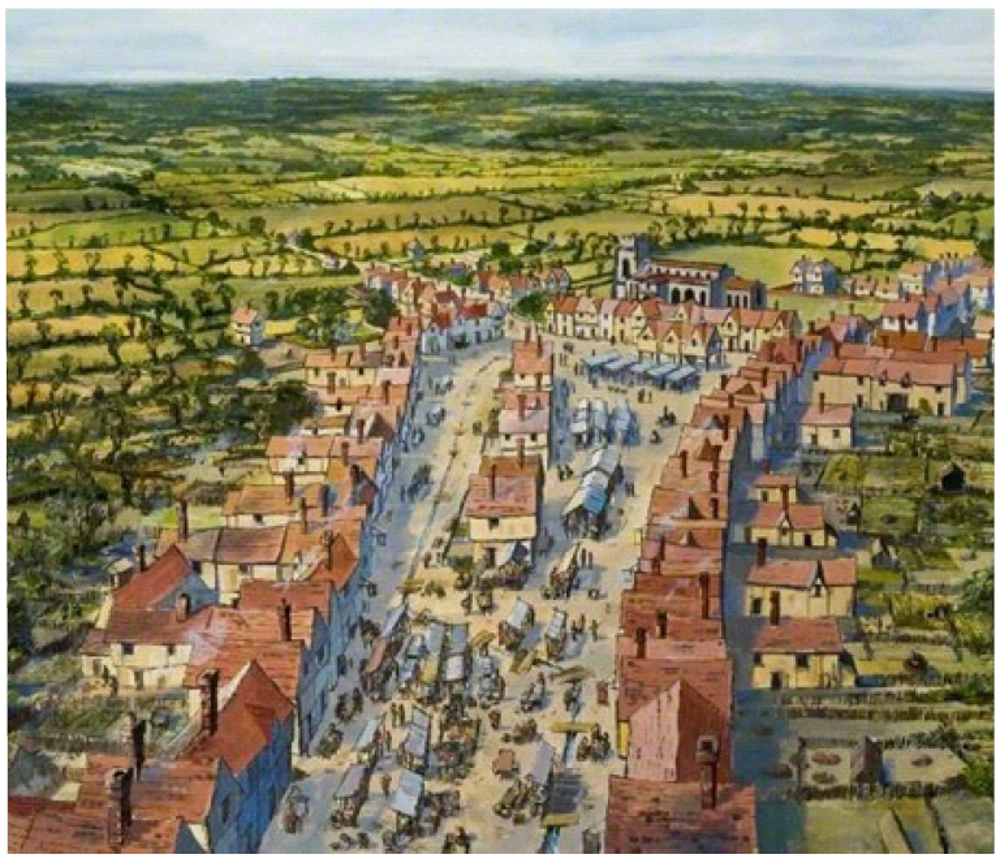Tindal Street Origins
Location of board
Tindal Street, outside wall of Boots
Medieval Market Town
The city of Chelmsford, as we now know it, is located in the heart of Essex countryside in a shallow river valley, at the confluence of two rivers. These rivers played an important part in Chelmsford's history and development, including the origins of its name.
Previously known as Ceolmaer's Ford, Chelmsford originated after a Saxon man gave his name to a fording place across a river flowing through the region. Over time, this river has simply become the River Chelmer and the place name shortened to Chelmsford.

Before this, Chelmsford was known as Caesaromagus, a Romano-British settlement centred around the area of Moulsham Street, south of Chelmsford's other river, the River Can. The fort was established on a road between London and Colchester following the Boudiccan revolt of 60-61 AD. Although Caesaromagus (Caesar's Market) declined in importance during the 4th Century, soon after, new invaders from Germany, the Saxons, landed and settled in the South East. During this time, the settlements shifted to rural land holdings in the surrounding countryside and the London to Colchester road was diverted through Writtle following the collapse of the bridge over the river.
After the Norman conquest of 1066, the land north of the Can was owned by the Bishop of London. Around 1100, he paid for a new wooden bridge to be built over the River Can, then known as the Great River. This was later replaced in 1372 by a stone bridge, an image of which appears on the city's coat of arms.
Not only did the bridge join the two hamlets of Chelmsford and Moulsham together, but it reinstated the direct route of the original Roman Road from Moulsham Street to Springfield Road, which still remains. As the traffic was diverted from the Royal Manor of Writtle back through Chelmsford, the importance of Writtle declined, as Chelmsford prospered once again.
In 1199, a charter was granted by King John for a weekly market to be held. The site of the market was an elongated triangle, stretching from Springfield Road up to the parish church (now the cathedral). Further charters gave the right to sell off plots of land for buildings and for an annual fair. These buildings were constructed within long, narrow rectangular plots which stretched down from the High Street frontage to the river's edge.
The medieval street pattern comprising New Street, Duke Street and the High Street that was formed in this time survives. The market place is still instantly recognisable in the current High Street layout today and some of the narrow plots also survive. The continuous retail use of the High Street from the medieval period means that the historic street pattern has been retained, although most of the buildings have been replaced, several times in some instances.
Conduit
In the 11th Century, early water supply for the town centre came from a spring named Burgeyswell in Burgeysfield, about half a mile northwest of the High Street. The water from the well, now hidden below Fairfield Road car park, was piped underground through the fields and down Duke Street where it spouted at a conduit, south of the church yard entrance, in what became known as Conduit Square. From there flowed a source of spring water which constantly ran down the High Street, behind the market place, as an open stream.

Although the origin of the conduit is not recorded, it is believed that it was built by Dominican friars who settled in Moulsham between 1234 and 1277. Given that the spring and field were known as Burgeyswell and Burgeysfield, it is likely that they belonged to John Burgeys, who was the benefactor of the friars in 1281.
When the friars laid an underground aqueduct from the spring to their own house in Moulsham, in 1341, it is believed that they assisted in leading the water into the town. Because of this engineering feat, Burgess Well contributed to the town's water supply for over six hundred years, until 1973.
The conduit has had several fountain heads since its installation, including a Greek water nymph or Naiad, which was installed in 1791, and later moved to Shire Hall. In 1814, the Naiad was replaced by a rotunda – a dome of stone upon six circular, tapered Doric columns – which was then moved to the junction of Springfield Road and the High Street in 1852. It can now be found in Tower Gardens, Admirals Park, where it was moved to in the early 20th Century.
Middlerow
As the lord of the manor, the Bishop of London owned the soil of the high street, including the upper part where the elongated triangle was. By the 1380s, parcels of the street were sold off by the bishop and his stewards, particularly down the middle. Out of this grew an island known as 'Middle Row', where various buildings sprang up in this space. Behind the market, a new lane, then known as 'Back Lane,' was created at the back of Middle Row on the western side of the High Street.
By 1384, the island became 'Shoprow' which grew gradually, a few feet at a time. Its origin began from the grant of 'stall-places,' which were movable market stalls that had to be taken away after the market closed. These then evolved into permanent stands located in precise pitches, eventually joining together to create larger shops and dwellings.

Over time, the watercourse, which ran from the conduit down the Back Street, alongside the buildings in Middle Row, became increasingly polluted. Although the water 'Chanell' from Burgess Well was pure spring water, it was used as a common gutter by the local residents who had houses in the Middle Row.
In 1474, William Breton of Middle Row was fined because his privy was reported to have been leaking into the channel and overflowing into the street, creating an awful smell. Instead of fixing the fault he made it worse by building an extension to the back of his house which contained a privy conveniently located above the channel, draining into it In due course, Breton's ingenious method of domestic sewage disposal was adopted by many others in the street who also lived conveniently alongside the channel. In 1499 and 1504, orders also had to be made to stop women washing their linen and garments in the street where the water surfaced.
In 1808, a large fire spread along Middlerow, destroying a number of timber frame buildings, which were replaced in brick and stone.
Eventually, the continuous house and shop expansions resulted in the encasement of the channel within them, contributing to a new stage in the town's evolution. In time, the highway behind the Middle Row was reduced to a narrow lane called Back Street or Conduit Street, before becoming Tindal Street in 1850.
Conclusion
Chelmsford has flourished as a market town since 1199 after receiving a market charter from King John to hold a weekly market. In 2012, Chelmsford was granted city status, recognising its significance as a retail, cultural and commercial centre within Essex.
Steeped in considerable history, Chelmsford continues to grow in resonance, regionally and nationally, building for its future whilst celebrating its past.
